Starting sketchbook journaling for creative growth is pretty simple and doesn’t require being a pro artist—just grab a sturdy sketchbook and some basic art supplies. Doodle, scribble, paste random ticket stubs, or splash colors however you like—mistakes are allowed, even celebrated. Pull inspiration from your day, try challenges, and don’t stress about perfection. It’s about having fun and seeing your skills improve bit by bit. Stick with it, and you’ll reveal even more awesome ideas next.
Key Takeaways
- Choose a durable, mid-sized sketchbook with thick paper suited for your preferred art mediums and consider customizing it for inspiration.
- Embrace daily life, nature, and art prompt challenges as ongoing sources of sketching ideas to fuel consistent creativity.
- Experiment with different materials, artistic techniques, and unconventional tools to broaden your creative horizons.
- Set aside regular time for sketchbook journaling, keeping supplies accessible and goals flexible to encourage steady practice.
- Welcome mistakes as learning opportunities, revisiting and revising previous pages to track and celebrate your artistic growth.
Understanding Sketchbook Journaling
Creativity is kind of like a wild animal—you never know when it’ll try to leap out, or just curl up and nap. That’s where sketchbook journaling comes in handy. A sketchbook acts as your personal playground for art, letting you doodle, splash colors, paste ticket stubs, or write wild thoughts without fear of being judged.
It’s all about the creative process—no pressure, just exploration. Within those blank pages, memories get saved, personal growth happens, and your ideas can run wild one day or quietly nap the next.
The cool part? You don’t have to finish a page right away; come back later, add more, or change your mind. Over time, your style and confidence grow, often in surprising ways.
Choosing the Right Materials
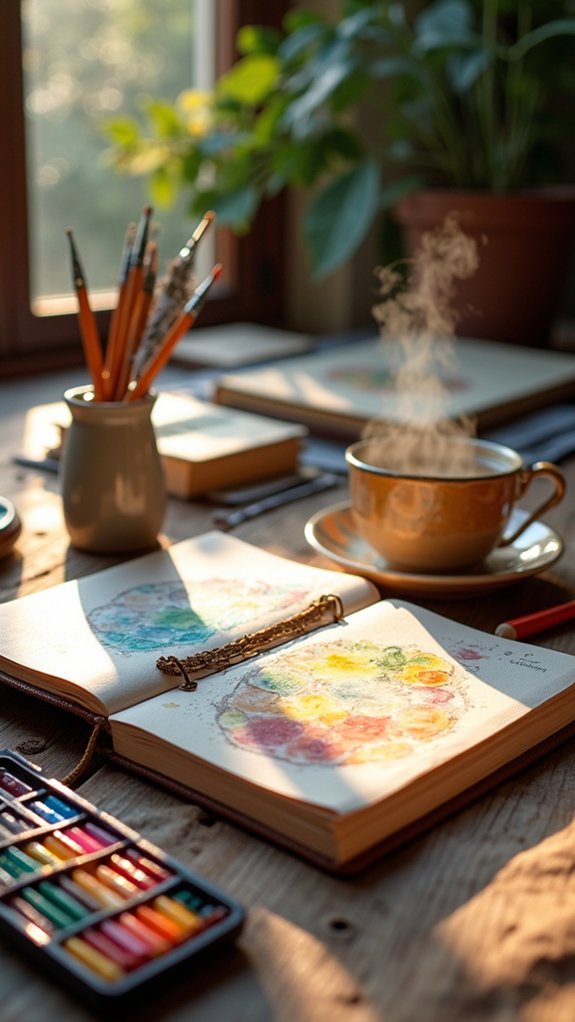
Before anyone’s creative ideas can truly run wild, there’s the big question of what to actually sketch or scribble on.
Picking the right sketchbook is like choosing a new sidekick—you want it to stand up to your wildest ideas and wildest art supplies! Durability matters, so grabbing paper that’s over 70 lbs lets your pencils, markers, or even watercolors join the party without bleeding through.
A mid-sized sketchbook is usually easiest to toss in a bag or sprawl out on a desk. Spiral bindings let pages flip easily, which is a game-changer for creative flow.
And for the earth-lovers out there, using upcycled materials, like an old notebook, can make every doodle feel one-of-a-kind. Reviews help, too. Choose what feels right!
Setting Up Your Sketchbook
Setting up your sketchbook is where the magic really starts—choosing the right book, grabbing your favorite pens or brushes, and maybe even turning an old notebook into something totally yours.
Some people love thick, sturdy paper that can handle anything from sharpie scribbles to wild watercolor splashes, while others pick a size that fits right in their backpack.
This is also the perfect time to add a personal touch, like decorating the cover or making a space inside for special notes, so your sketchbook feels like your own secret world.
Choosing the Right Sketchbook
While picking out a sketchbook might sound easy, it’s actually the first big adventure of sketchbook journaling. There’s so much more to it than grabbing the shiniest cover off the shelf!
Check the paper weight first—over 70 lbs is best, especially if you want to splash some watercolor or get bold with acrylics.
Next, sketchbook size matters. A mid-sized one is easy to stash in a backpack or swing open during a burst of creative inspiration.
Don’t be shy about reading reviews; artists share their victories and disasters online.
Feeling extra creative? Try upcycling an old book into your own handmade sketchbook.
The best sketchbooks tell the story of your artistic journey, page by page, getting more beautiful—and a little messier—each day.
Selecting Essential Materials
Supplies are where the real fun begins, because every artist needs a toolkit ready for action. Picking out sketchbook materials feels a bit like gearing up for an epic quest—seriously, a good sketchbook has paper thicker than most sandwiches (over 70 lbs!), so it can handle watercolors or bold pens without buckling.
Go for a mid-sized one—it’s easier to carry, not too tiny, and leaves enough room for creative expression without getting overwhelming. Spiral-bound books are great for ripping out pages or laying them flat, but stitched ones might need a clip.
Don’t forget archival glue, so all those ticket stubs, leaves, or cool memorabilia you collect will actually stick around. Upcycle old books or papers if you love giving things new life!
Personalizing Your Journal
Once the perfect sketchbook is in hand, the real adventure is turning those blank pages into a space that actually feels like “yours.”
Think of it as decorating your secret clubhouse—maybe one page becomes a garden for doodles, and another a gallery for movie ticket stubs or pressed clovers.
Personalizing your journal means setting up each page with a theme that sparks your creative journey, keeps things fun, and boosts visual inspiration.
You can use pencil drafts to lay out your ideas, deciding where everything will go before adding color or details.
Don’t stress about messing up! Sometimes, leaving a page half-finished is part of art journaling—it helps you come back later with fresh ideas.
Each page helps you develop your skills, making your journal uniquely you.
Finding Inspiration and Prompts
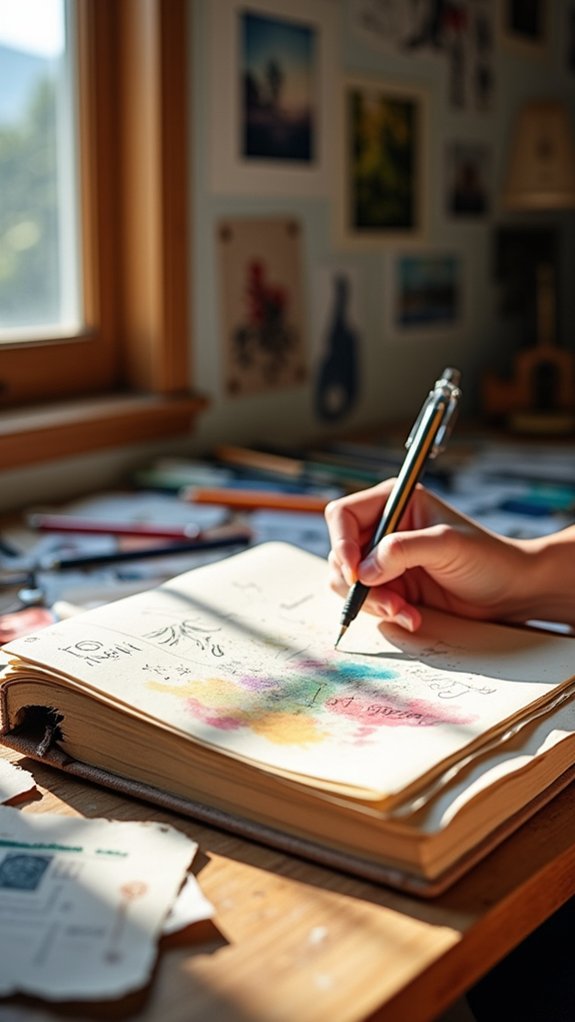
Finding inspiration for your sketchbook journal can be as simple as watching people in the park, checking out the weird shape of a cloud, or even sketching your mashed potatoes at dinner (they deserved some attention).
Nature and the world around you are full of surprises, while art prompt challenges online are like treasure chests packed with ideas just waiting to be cracked open.
When creativity feels stuck, these sparks can help turn a blank page into a story—or at least a really cool drawing of your neighbor’s suspicious-looking cat.
Everyday Life Observation
Inspiration can sneak up on anyone, especially when least expected—like while munching on breakfast cereal or eavesdropping on a funny conversation at the bus stop.
Everyday life is crammed with moments just begging to be noticed, sketched, or jotted down. For sketchbook journaling, the trick is to carry a pocket notebook or doodle pad, ready to catch whatever grabs your attention.
Maybe it’s the peanut butter toast that looks like a Picasso, or the goofy neighbor walking his lizard (yes, lizard!) on a leash. The goal isn’t perfect art—it’s creative growth and sharpening observation skills.
Nature and Surroundings
Everyday routines offer plenty to spark a sketchbook, but stepping outside opens up a whole new world of inspiration. Nature has so many surprises!
Just think: one moment you’re watching a squirrel launch itself onto a bird feeder, the next you’re noticing a weird, lumpy mushroom under a shady tree.
To make your sketchbook truly creative and memorable, use your observational skills to document what you find. Here are four ways to help your nature journaling:
- Sketch the view from your favorite outdoor spot—be dramatic!
- Document the textures of leaves, bark, or rocks; get up close and personal.
- Add pressed flowers or leaves for a cool mixed-media touch.
- Create themed pages for forests, coasts, or even the city’s scrappy green spaces.
Nature’s your ultimate inspiration!
Art Prompt Challenges
Ever get stuck just staring at a blank page, wondering what on earth to draw next? That’s where art prompts come to the rescue! Art prompt challenges are like creative superheroes for your sketchbook journal. They hand you a theme or idea—like “draw your favorite place,” or “illustrate a memory from last week.”
Suddenly, that scary blank page feels way less intimidating. Engaging with daily or weekly prompts, especially through online groups, builds a sense of community and accountability. Plus, it’s just really fun to see what others create!
Journaling helps stretch your imagination, and trying different sources for prompts gives your art fresh energy. Keep a list handy for instant inspiration and watch your creative growth take off. Blank page, who?
Developing Page Themes and Layouts
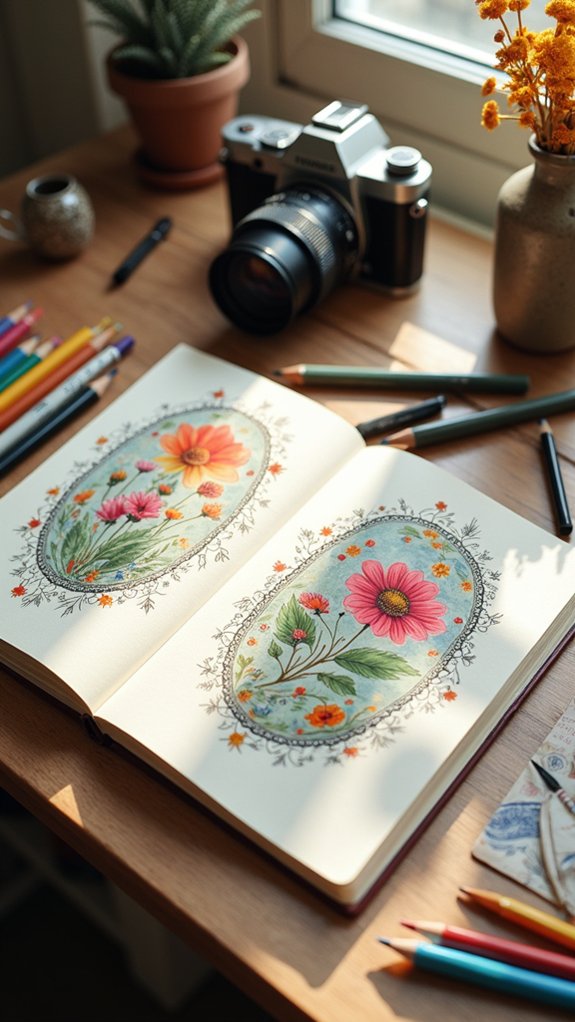
Although opening a blank page might feel intimidating at first, choosing a theme can actually turn it into something exciting—like building a special world just for your ideas.
Picking a theme helps you organize your thoughts, and planning different layouts lets you play with where everything goes. It doesn’t have to be fancy or perfect—sometimes a squirrel in a superhero cape makes the perfect page centerpiece.
The best part? There’s so much flexibility! You can:
- Start with a pencil draft to plan your layouts before adding color.
- Take your time, letting each page reflect your personal expression.
- Add to or change pages anytime, encouraging creative growth.
- Decide for yourself when a page feels finished—no rules, just your unique style!
Let your sketchbook be your creative playground!
Experimenting With Techniques and Mediums
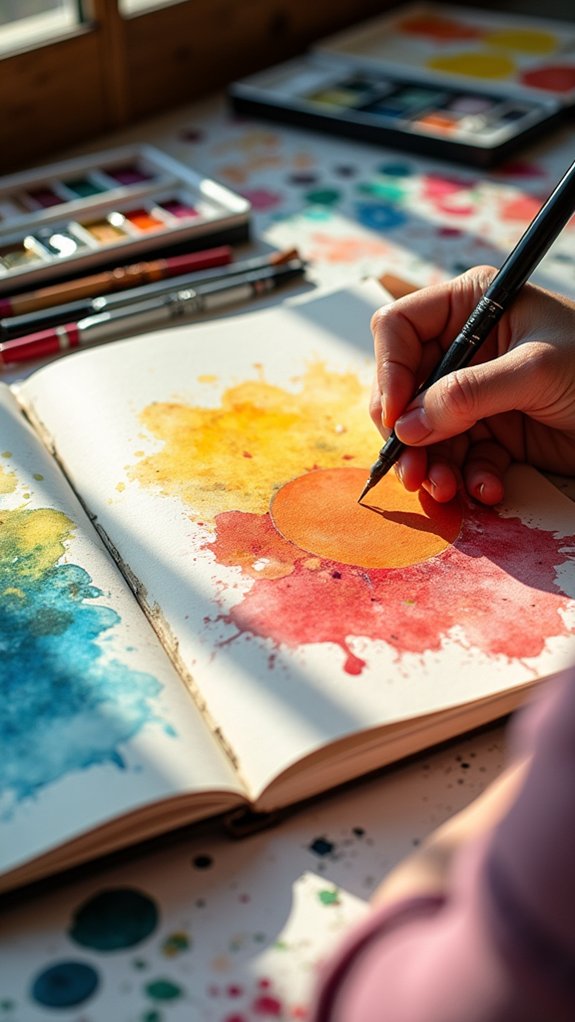
Dive right in—sketchbook journaling isn’t just about drawing; it’s about exploring all sorts of wild and wonderful ways to fill those blank pages.
Don’t be afraid to experiment! Try painting with coffee, scribbling with colored pencils, or mixing watercolors and acrylics.
Every medium feels different—watercolors flow, acrylics pop, and even weird stuff like glue or magazine cutouts can totally change your art.
Test how these mediums react on thick paper (over 70 lbs is best if you don’t want a soggy mess).
Fun techniques like layering or using unexpected objects can spark tons of creative ideas.
Messing up is part of the journey, so don’t sweat it—document everything.
Revisiting and adding to your pages later can reveal new, imaginative directions in your art.
Building a Creative Routine
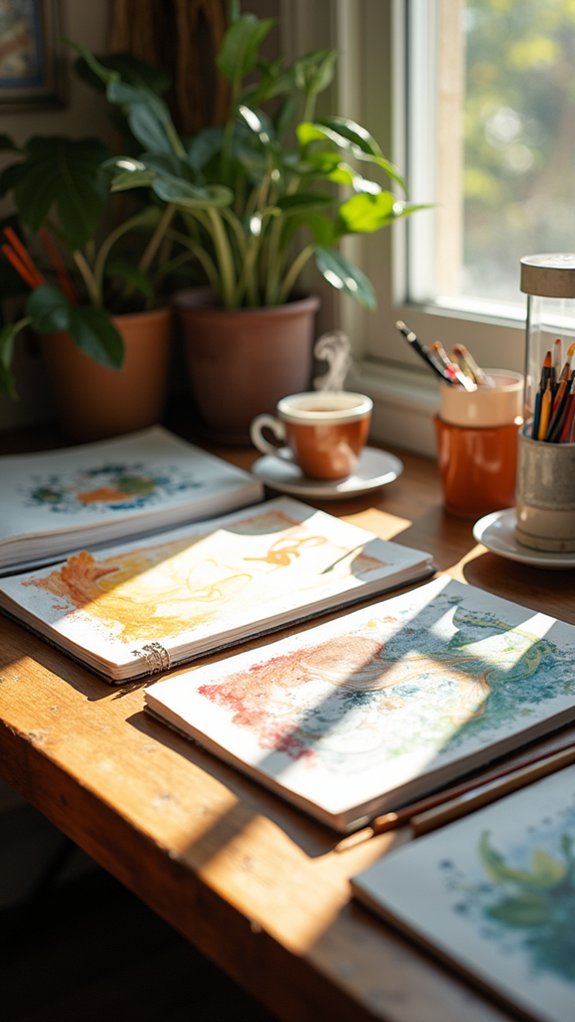
A solid creative routine can turn sketchbook journaling from a random hobby into something powerful—think of it like leveling up in a video game, but for your imagination.
If you want to grow creatively, routines matter! Here’s how to make your process epic:
- Set a consistent schedule—Pick certain days or times and make journaling a habit, like brushing your teeth, but way more fun.
- Define specific goals—Challenge yourself to try new things, like sketching with markers one day, or filling a page with silly doodles.
- Keep supplies accessible—Having your sketchbook and pens close by is half the battle—don’t let a missing pencil ruin your creative streak.
- Celebrate small achievements—Finishing a page or trying a new style is awesome—give yourself a mini high-five for every win!
Reflecting on Your Artistic Growth
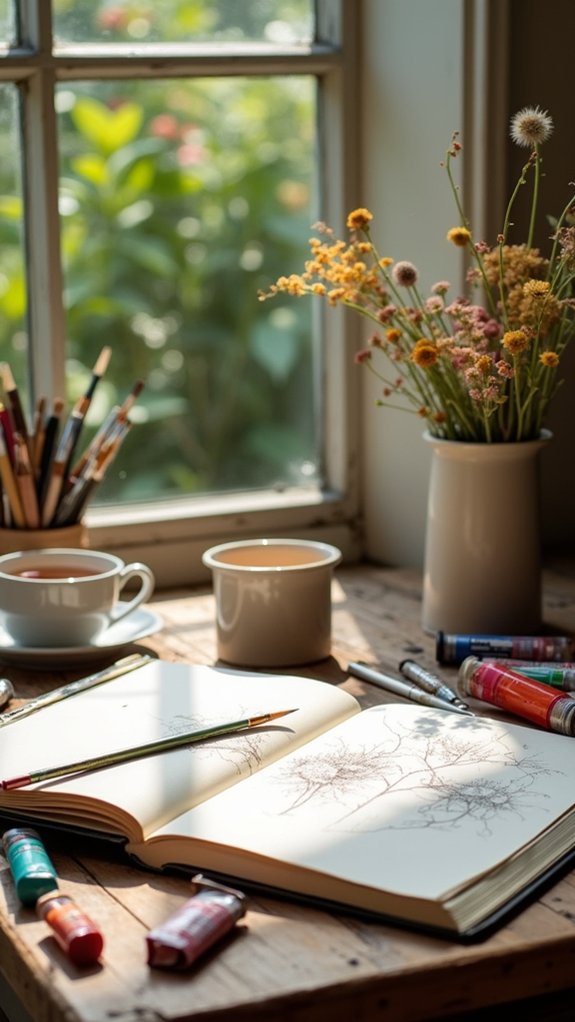
Flipping back through old sketchbook pages can feel like digging up buried treasure—one moment someone’s cringing at their awkward stick figures, the next they’re grinning at a drawing that actually nailed the look they were going for.
Reflecting on this personal timeline gives anyone a front-row seat to their artistic growth. It’s like having a visual diary that doesn’t just show what you made, but how you’ve changed throughout your creative journey.
Adding dates is super helpful, too; you get to see exactly when your style shifted or your confidence grew. When people revisit their sketches, it often sparks self-awareness, helping them spot what’s working and what isn’t.
All this reflection isn’t just nostalgia, either—it’s motivation to keep going and keep growing.
Frequently Asked Questions
What Do I Need for Creative Journaling?
To begin, individuals should gather essential supplies, choose suitable sketchbook types, and explore journaling techniques. Incorporating creative prompts and identifying inspiration sources will help foster a dynamic, personal journaling practice tailored to varied artistic preferences and goals.
What Should I Draw First in My Sketchbook?
When considering what to draw first in a sketchbook, one might explore inspiration sources such as drawing prompts, favorite subjects, artistic styles, or personal themes, allowing experimentation and self-discovery to guide the initial creative direction.
Can You Use a Sketchbook for Journaling?
A sketchbook can be used for journaling by combining visual storytelling, sketchbook prompts, and various journaling techniques. This approach supports art therapy and creative expression, enabling personal reflection and growth through both images and written elements.
How to Start a Daily Sketchbook Practice?
To start a daily sketchbook practice, one establishes habit building with creative goals, uses daily prompts for direction, explores varied sketching techniques, and draws from diverse inspiration sources, fostering consistent artistic development and sustained personal growth.
Conclusion
Starting a sketchbook journal isn’t just about drawing—it’s a way to see your own ideas grow right on the page, kind of like a science experiment, but messier and way more fun. With the right tools, a dash of curiosity, and zero fear of making “mistakes,” anyone can level up their creativity. So, why not plunge in? The next masterpiece or hilarious doodle could be just a page turn away—no erasers required.

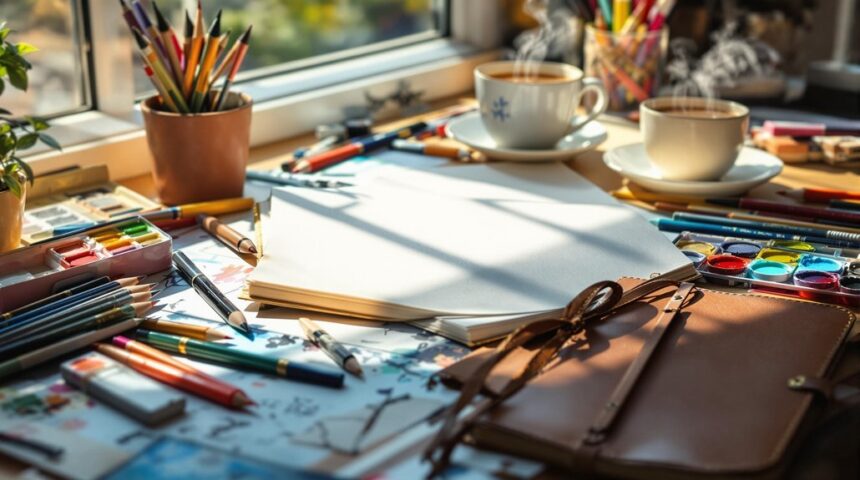
Leave a Reply